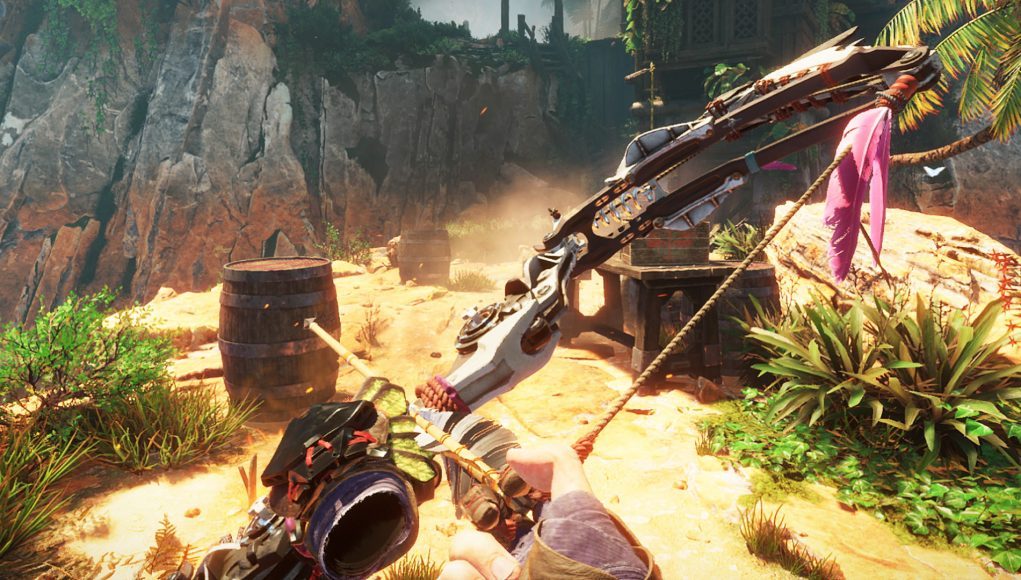One of the big questions on my mind ever since the announcement of Horizon Call of the Mountain for PSVR 2 is whether it would be a short ‘experience’ designed as a simple demo for the headset, or a full blown game. After going hands-on with the title I’m happy to report that it not only aims to deliver a full campaign, but it’s also brimming with insightful VR design.
We’ve seen it before and I’m sure we’ll see it again—a big name studio tries their hand at creating a VR game and the end result makes it seem like they never really ‘got’ VR in the first place.
After nearly an hour of hands-on with the game on PSVR 2, I’m satisfied this will not be the case with Horizon Call of the Mountain.
Check out our detailed hands-on with PSVR 2 hardware
Developed in conjunction with Sony’s first-party Guerrilla Games and Firesprite Studios—it’s clear that not only do the people building the game ‘get’ VR, but they get it well enough to think outside the box and introduce novel VR mechanics that are quite promising.
My time with Horizon Call of the Mountain started with the ‘river ride’ that was revealed in the announcement trailer. While it was suggested previously this might be a separate little demo experience that’s attached to the game, it turns out this is essentially the very start of the campaign—and visually it looks every bit as good as the trailer suggests, right down to the lens flares coming off of the robotic beasts.
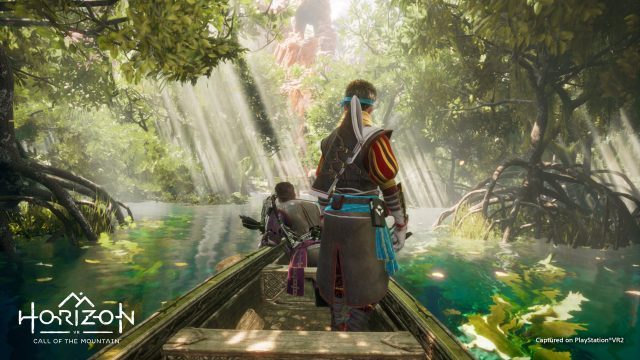
But beauty in a Horizon game never guarantees safety… it wasn’t long before I was tipped out of the boat by one of the machines and had to swim and climb my way to safety.
It became soon apparent the developers have really sat down and thought carefully about how they wanted Call of the Mountain to play as a VR game. By default (at least at this stage) players are immediately introduced to an ‘arm swinger’ locomotion method (where you hold a button and swing your arms to move forward) which quickly came to feel quite natural and immersive. The studios say the game supports typical thumbstick movement too, but I didn’t feel compelled to enable it during my time with the game.
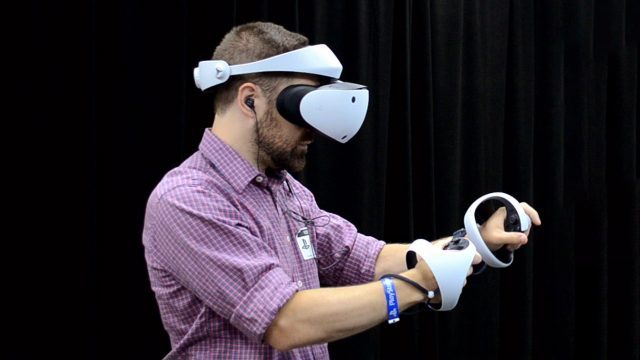
Beyond swinging your arms to walk about, it’s clear that climbing will be a big part of the game (and, hey… if a mountain is indeed calling you, you’d better expect to do some climbing). That’s made quite easy thanks to PSVR 2’s new motion controllers which handled the task deftly, as well as the subtle and engaging visual affordances the studio is using to make your climbing path clear without being too obvious.
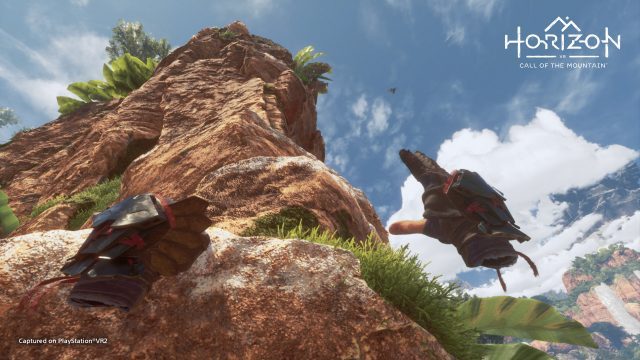
The game’s locomotion method is far from the only thoughtful thing it’s doing as far as VR is concerned. As I progressed through the start of the game I was happily surprised to find a world convincingly full of interactive objects and a solid physics-based interaction system. I was happy to find on multiple occasions that my instinct to reach out and touch hanging vines and large plants was rewarded with them actually responding to my touch.
And beyond just vegetation, the studio seems intent on filling the world with interactive objects for the player to discover. There’s barrels and boxes strew about which you can look inside of to find loot. Small artifacts—like pots, tools, and dolls—to pick up and inspect (or, let’s be honest… throw and smash into pieces). And I spotted a handful of interactive objects that had secondary functions to add to the game’s immersion: there was a paintbrush which could be used to paint on a cave wall, drums which could be played with mallets, and even a makeshift maraca instrument which made a satisfying rattling sound when shaken.
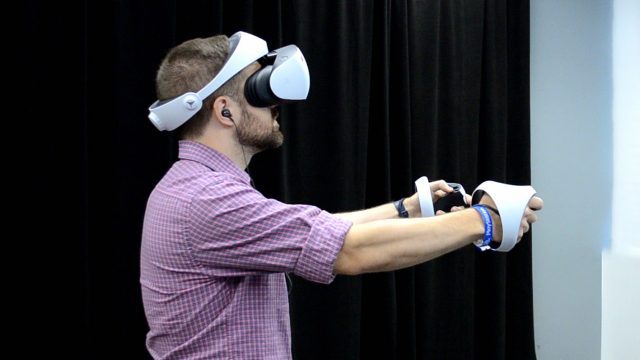
Frankly… I’ll be impressed if the studio can keep up this level of interesting VR interactivity throughout the entire campaign without simply re-using the same few items. Fingers crossed.
But smashing pots and painting cave walls is far from the main thrust of the gameplay. It wasn’t long before I got my hands on a bow, and it became apparent quickly that this will be the game’s main combat tool.
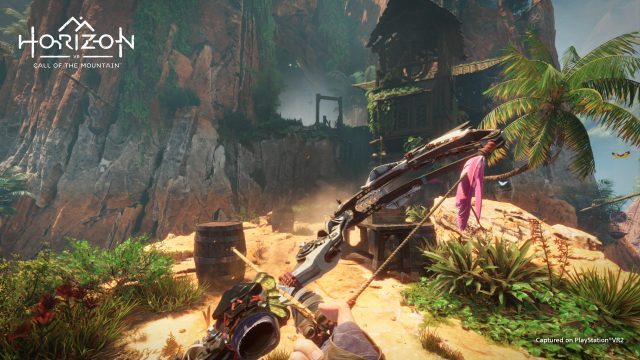
As far as gameplay implementation goes, the bow is pretty standard for what you’d find in a VR game… you can pull an arrow from the quiver on your back, draw the bow, and fire. But Horizon Call of the Mountain is adding its own unique flavor to VR bow combat by innovating on the locomotion side.
Once you start a fight with one of the machines, you’re attached to a circular ‘track’ that spans the fighting area. By ‘grabbing’ in the air with the controller and then pulling your hand left or right, you slide along the track, allowing you to quickly strafe and dodge around the enemy while stopping to let some arrows fly.
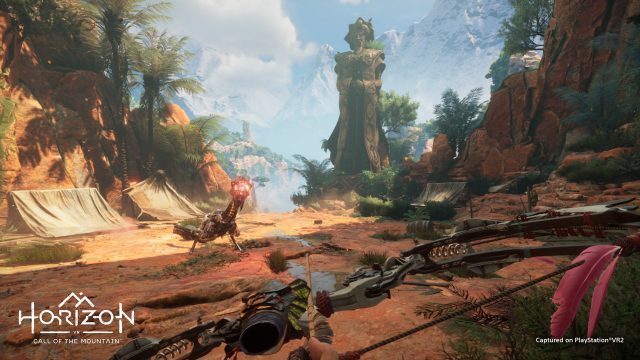
On paper the system sounds a bit… weird… but it not only makes nimbly navigating fights much easier than free-form locomotion, it also helps make it really feel like a Horizon VR game.
It’s common in the non-VR entries of the franchise to fight large, well armored machines that need to be picked apart strategically rather than destroyed in just a few hits. In practice many of the fights really do involve strafing in large circles around dangerous foes to dodge their attacks and return fire. The circle-strafe system in Horizon Call of the Mountain aims to bring that sort of combat into VR in a way that’s both comfortable and indicative of the source material.
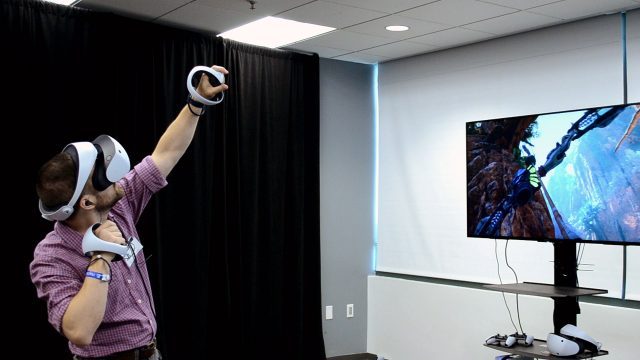
So far I find the system intriguing and I’d say it seems to work well. A big question on my mind is whether it will become stale if overused; the developers didn’t want to say much more but teased that they have ideas for keeping combat fresh as the player progresses.
Graphically, Horizon Call of the Mountain is steps beyond anything we’ve seen to date on the original PSVR. It’s not just the far higher resolution on PSVR 2, but the power of PS5 is clearly being tapped to create lush and detailed environments, which I’d say are approaching Half-Life: Alyx in terms of quality.
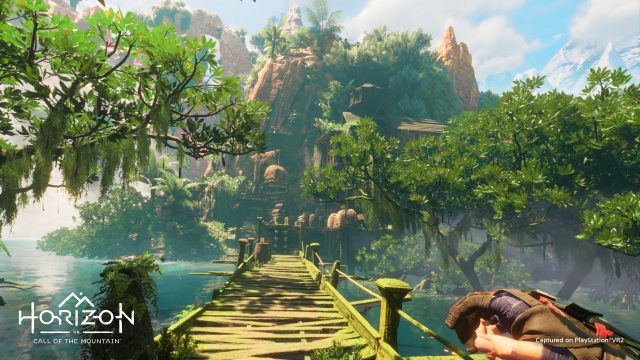
In my time with the game it’s clear that exploration, climbing, and bow combat are major pillars of gameplay, but the developers are also promising a rather in-depth crafting system that has yet to be revealed, along with puzzle-solving and an “epic” story. Much of the crafting, it seems, will involve creating new arrow types… though the developers have also teased that you’ll have more interesting tools than just the bow.
Together that will form what the developers say will be a story campaign in the order of seven hours or so, plus some “additional content” included in the game (I’m thinking something like an ‘arena mode’ is a likely addition for replayability).
– – — – –
The developers aren’t saying if Horizon Call of the Mountain will be a launch title for PSVR 2, but considering the mature state of the game as I’ve experienced thus far, it certainly seems likely. Ultimately I’m impressed with what I’ve seen and hopeful that Guerrilla and Firesprite manage to keep hitting the impressive bar they’ve set with the game’s gameplay and interactivity.
Disclosure: Sony assisted with travel & lodging expenses to an event where information for this article was gathered.

